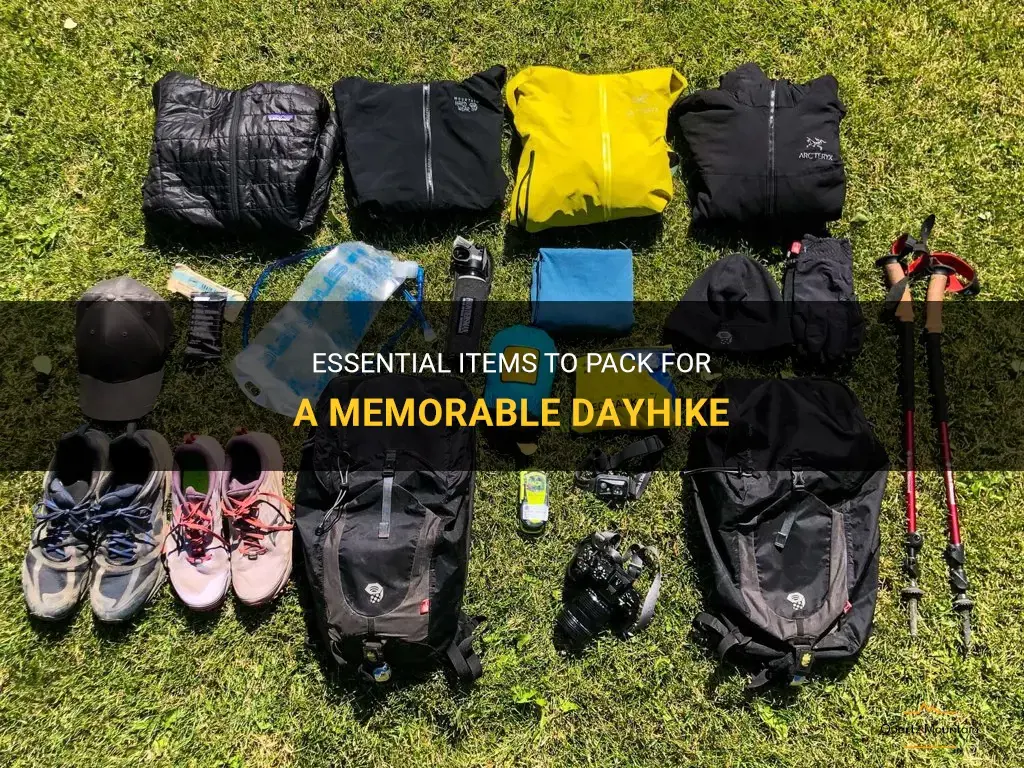
Are you planning a dayhike but unsure of what to pack? Don't worry, we've got you covered! Whether you're a seasoned hiker or a beginner, it's important to have the right essentials to ensure a memorable and enjoyable experience. From the obvious items like water and snacks to the not-so-obvious items like a map and first aid kit, we've compiled a list of the must-have items to pack for your next dayhike. So grab your backpack and let's get ready to explore the great outdoors!
| Characteristics | Values |
|---|---|
| Backpack | Yes |
| Water | Yes |
| Snacks | Yes |
| Map | Yes |
| Compass | Yes |
| First aid kit | Yes |
| Sunscreen | Yes |
| Hat | Yes |
| Sunglasses | Yes |
| Extra clothes | Yes |
| Hiking boots | Yes |
| Rain gear | Optional |
| Insect repellent | Optional |
| Trekking poles | Optional |
| Phone | Yes |
What You'll Learn
- What are the essential items to pack for a day hike?
- How should I choose the right backpack for a day hike and what should I put in it?
- Are there any specific clothing items or gear that are necessary for a day hike?
- What should I bring for food and hydration for a day hike?
- Are there any additional items or safety precautions I should consider when packing for a day hike?

What are the essential items to pack for a day hike?
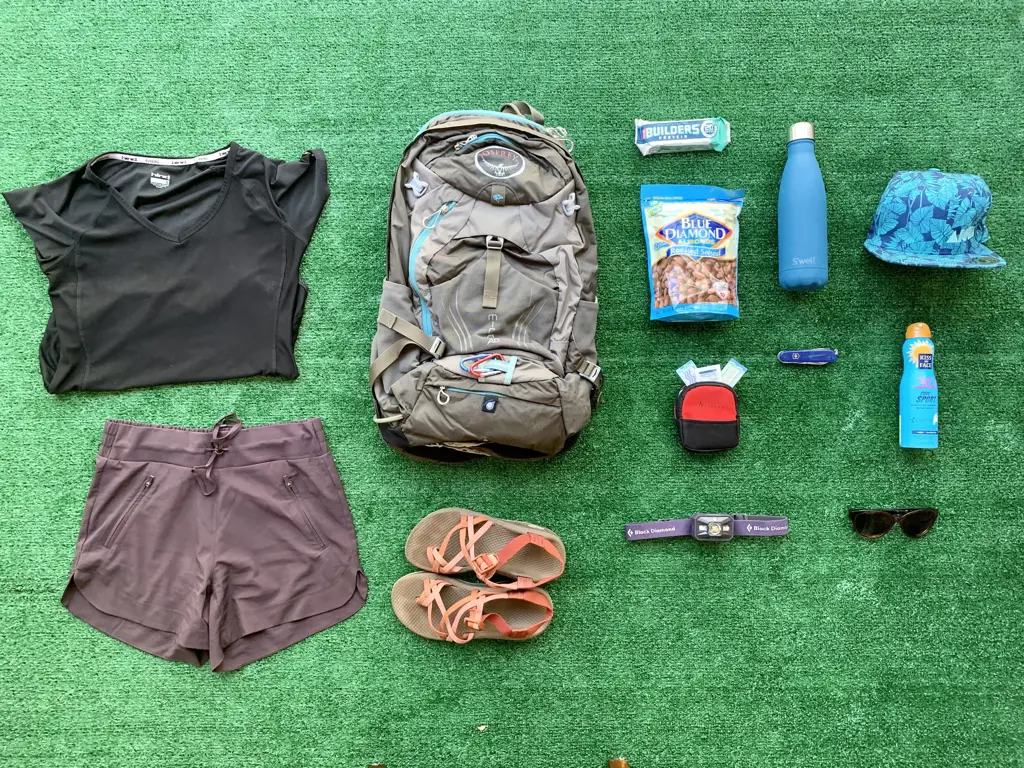
When planning for a day hike, it is important to pack the essential items to ensure a safe and enjoyable experience. Whether you are a seasoned hiker or a beginner, having the right gear and supplies can make all the difference. This article will outline the essential items to pack for a day hike, providing you with a comprehensive guide.
- Navigation tools: One of the most important items to pack for a day hike is a map and compass or a GPS device. These tools will help you navigate your way through the trail, ensuring you stay on course and avoid getting lost. It is also advisable to familiarize yourself with the route before setting off, as this will further reduce the chances of getting lost.
- Water: Staying hydrated is crucial when hiking, especially on a hot day. It is recommended to carry at least 2 liters of water per person, and more if you are hiking in a remote area where water sources may be scarce. Consider using a hydration bladder or water bottles that are easy to carry and accessible on the go.
- Food: Pack enough food for the duration of your hike, including snacks to keep your energy levels up. Trail mix, energy bars, and dried fruits are lightweight and easy to carry. It is best to choose foods that are high in nutrients and provide sustained energy, such as nuts, seeds, and jerky.
- First aid kit: Accidents can happen even on short day hikes, so it is essential to have a basic first aid kit with you. This should include items such as band-aids, gauze pads, antiseptic wipes, adhesive tape, and pain relievers. Additionally, if you have any specific health conditions or allergies, make sure to pack any necessary medications.
- Sun protection: Being exposed to the sun for extended periods can lead to sunburn and other skin damage. Therefore, it is important to pack sun protection items such as sunscreen, a wide-brimmed hat, and sunglasses. Choose a sunscreen with a high SPF rating and consider applying it before starting your hike, as well as reapplying throughout the day.
- Clothing and footwear: Depending on the weather and terrain, it is crucial to wear appropriate clothing and footwear for your day hike. Choose moisture-wicking and breathable fabrics to help regulate body temperature. Layers are also important, as temperatures can vary throughout the day. Make sure to wear comfortable and sturdy hiking shoes or boots with good traction for added stability and protection.
- Emergency shelter: Although a day hike may not involve overnight stays, it is still important to carry emergency shelter options such as a lightweight tent, a bivvy bag, or an emergency blanket. These items can provide protection from the elements in case of unexpected situations or a change in weather conditions.
- Personal hygiene items: While not as critical as the other items on this list, personal hygiene items can greatly improve comfort during a day hike. Consider packing hand sanitizer, biodegradable toilet paper, wet wipes, and a small towel. Leave no trace principles should be followed, meaning whatever you bring in, you should bring out.
- Other miscellaneous items: Depending on the specific requirements of your hike, there may be additional items to consider. These can include insect repellent, a headlamp or flashlight, a whistle, a multi-tool, and a small repair kit for any gear or equipment issues that may arise.
In conclusion, packing the essential items for a day hike is essential for a safe and enjoyable experience. Navigation tools, water, food, a first aid kit, sun protection, appropriate clothing and footwear, emergency shelter options, personal hygiene items, and other miscellaneous items should be considered when preparing for a hike. Always remember to check local regulations and weather conditions before setting off, and inform someone about your hiking plans for added safety.
Essential Items for Your Travel Packing Checklist
You may want to see also

How should I choose the right backpack for a day hike and what should I put in it?
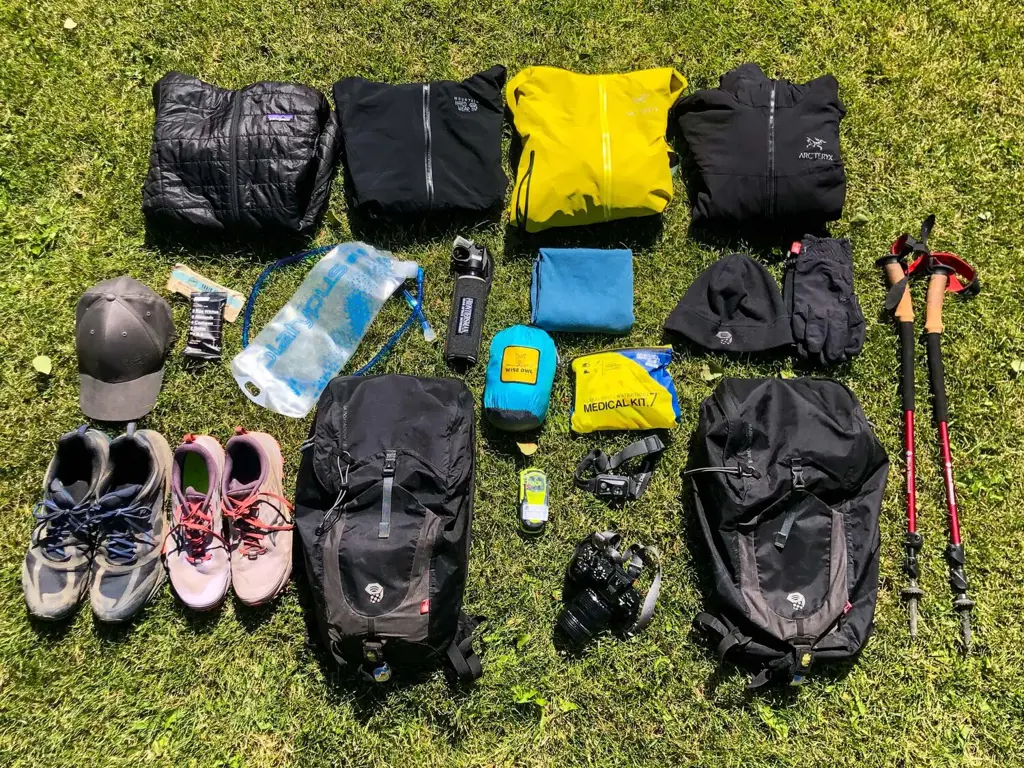
How to Choose the Right Backpack for a Day Hike and What to Put in It
Choosing the right backpack for a day hike is crucial for a comfortable and enjoyable outdoor experience. The backpack should not only fit your body properly but also be able to accommodate all the necessary items for the hike. Additionally, it should be durable and lightweight to ensure ease of movement. In this article, we will discuss how to choose the right backpack for a day hike and what items to put in it.
Step 1: Determine the Capacity
The first step in selecting the right backpack is to determine its capacity. Most daypacks range from 20 to 35 liters in size. The capacity you choose depends on the duration and type of hike. For a day hike, a backpack with a capacity of 20 to 30 liters should be sufficient to carry essential items such as water, food, extra clothing, and a first aid kit.
Step 2: Consider the Fit
The next important factor to consider is how well the backpack fits your body. Look for a backpack that has adjustable shoulder straps, a chest strap, and a hip belt. These features will help distribute the weight evenly and stabilize the backpack while you hike. Adjust the straps and belt to ensure a snug fit without any discomfort or chafing.
Step 3: Check for Durability
Since backpacks undergo rigorous outdoor use, it's important to choose one that is durable and made with high-quality materials. Look for backpacks made from water-resistant or waterproof materials such as nylon or polyester. Additionally, check the stitching and zippers for durability. Reinforced stitching and sturdy zippers will ensure the backpack can withstand the demands of hiking in various weather conditions.
Step 4: Assess the Weight
When selecting a backpack for a day hike, weight is an important consideration. You don't want to start your hike already feeling weighed down by a heavy backpack. Choose a lightweight backpack that won't add unnecessary strain to your hike. Look for backpacks made with lightweight materials and minimalist designs, without compromising durability.
Step 5: Organize and Pack the Essentials
Once you have found the perfect backpack, it's time to pack it with the essential items for your day hike. Here is a list of items you should consider carrying:
- Water: Carry enough water to stay hydrated throughout the hike. Consider a hydration system or use a water bottle.
- Food: Pack lightweight, high-energy snacks that can sustain you throughout the hike. Energy bars, nuts, and dried fruits are popular choices.
- Extra Clothing: Depending on the weather conditions, pack an extra layer of clothing such as a lightweight jacket, hat, or gloves.
- First Aid Kit: Always carry a basic first aid kit that includes bandages, antiseptic wipes, pain relievers, and any necessary prescription medications.
- Navigation Tools: Bring a map, compass, or hiking GPS device to help navigate unfamiliar trails.
- Sun Protection: Wear a hat and sunglasses, and apply sunscreen to protect your skin from harmful UV rays.
- Emergency Supplies: Carry a whistle, lighter, and a small flashlight in case of emergencies.
- Personal Items: Don't forget to pack your personal items such as a wallet, cellphone, and identification.
Choosing the right backpack for a day hike is important for a comfortable and successful outdoor experience. Consider the capacity, fit, durability, and weight of the backpack before making a decision. Once you have the perfect backpack, pack it with essential items such as water, food, extra clothing, a first aid kit, navigation tools, sun protection, emergency supplies, and personal items. With the right backpack and well-packed essentials, you'll be ready for a memorable day hike in the great outdoors.
Essential Tips for Packing for Your Rutgers Apartment
You may want to see also

Are there any specific clothing items or gear that are necessary for a day hike?
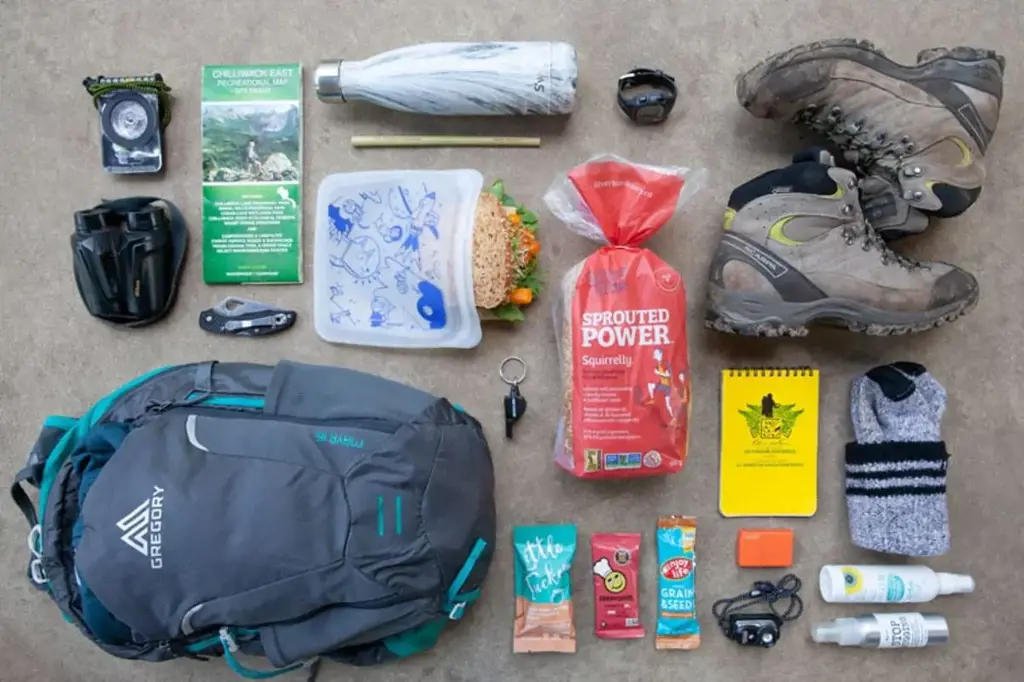
When preparing for a day hike, it is important to have the appropriate clothing and gear to ensure a comfortable and safe experience. While the specific items you need may vary depending on the terrain and weather conditions, there are a few essentials that every hiker should consider.
- Proper Footwear: One of the most crucial items for a day hike is a good pair of hiking boots or shoes. These should provide ankle support and have a sturdy sole to prevent slips and falls. Make sure to break in your footwear before your hike to avoid blisters and discomfort.
- Moisture-Wicking Clothing: It is advisable to wear moisture-wicking clothing on a day hike, as it helps to regulate body temperature and prevents the accumulation of sweat. Choose lightweight, quick-drying fabrics that will keep you dry and comfortable throughout your hike.
- Layering System: Depending on the weather conditions, it is important to dress in layers. This allows you to adjust your clothing according to your body temperature and the changing weather. Start with a base layer made of a moisture-wicking fabric, add a mid-layer for insulation, and top it off with a waterproof and windproof outer layer.
- Hat and Sunglasses: Protecting yourself from the sun is essential when hiking. A wide-brimmed hat helps shield your face and neck from the sun's harmful rays, while sunglasses protect your eyes from glare and UV radiation.
- Backpack: A backpack is essential for carrying all your gear and supplies. Look for one that is comfortable, with padded shoulder straps and a hip belt to distribute the weight evenly. Consider the size of your backpack based on the length of your hike and the amount of gear you plan to bring.
- Navigation Tools: It is important to carry a map and a compass (and know how to use them) when hiking. These tools will help you stay on track and navigate tricky terrain. Additionally, you can also consider using a GPS device or a hiking app on your smartphone for additional navigation support.
- First Aid Kit: Accidents can happen on the trail, so it is crucial to have a basic first aid kit with you. This should include bandages, antiseptic wipes, pain relievers, and any prescribed medications you may require.
- Snacks and Water: Staying hydrated and fueled is essential during a hike. Pack enough water for the duration of your hike, as well as some snacks to keep your energy levels up.
- Trekking Poles: Trekking poles can provide stability and support when navigating uneven terrain or steep slopes. They can also help to reduce strain on your knees and joints.
- Emergency Supplies: In case of an emergency, it is always wise to carry extra supplies such as a headlamp, a whistle, a fire starter, and a lightweight emergency blanket.
Remember, it is crucial to check the weather forecast before heading out on a hike and adjust your clothing and gear accordingly. It is also advisable to inform someone about your hiking plans and estimated return time, as well as to hike with a buddy whenever possible. By being well-prepared with the appropriate clothing and gear, you can ensure a safe and enjoyable day hike.
Essential Items to Pack for a Memorable Trip to Delhi
You may want to see also

What should I bring for food and hydration for a day hike?
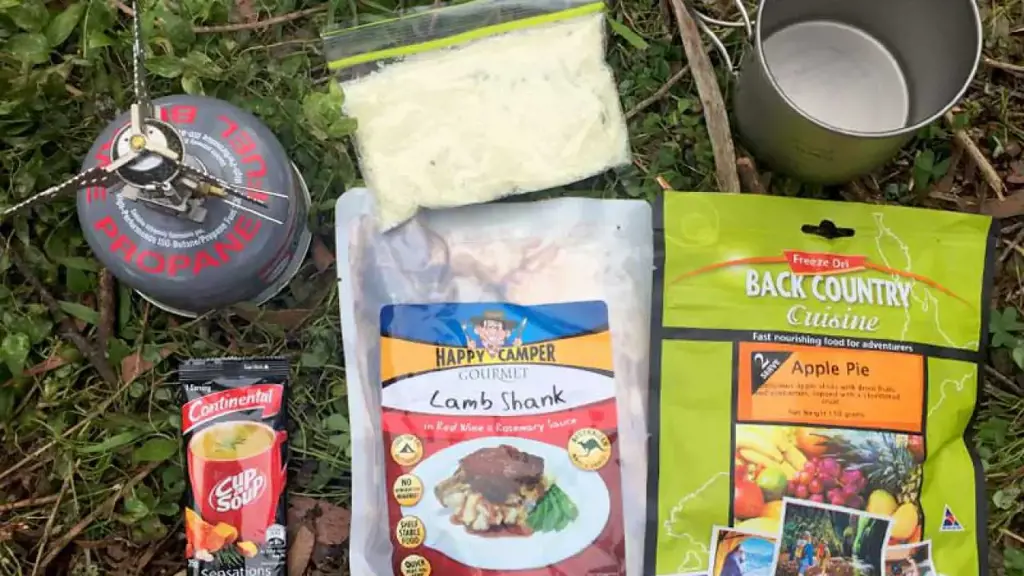
When embarking on a day hike, it's essential to bring sufficient food and hydration to sustain your energy throughout the journey. Here are some important considerations and guidelines for packing food and drink for a day hike.
Stay Hydrated:
Staying hydrated is crucial during a hike, as physical exertion and exposure to the elements can lead to dehydration. It is recommended to carry at least two liters (or 64 ounces) of water per person for a day hike. You can opt for a hydration bladder or water bottles depending on personal preference, but make sure they are lightweight and easy to carry. It's always a good idea to bring a water filter or purification tablets if you plan to refill your water along the trail.
Choose the Right Snacks:
Selecting the right snacks will provide you with the necessary energy to fuel your hike. Opt for lightweight, non-perishable foods that are high in calories and nutrients. Some great options include trail mix, energy bars, jerky, dried fruits, nuts, and nut butter packs. These snacks are packed with proteins, healthy fats, and carbohydrates, offering a balance of quick and long-lasting energy.
Pack a Nutritious Lunch:
In addition to snacks, it's important to pack a nutritious lunch that will keep you satisfied and provide sustained energy. Choose foods that are easy to eat on the go and won't spoil in your pack. Some excellent choices include wraps or sandwiches with lean proteins like turkey or chicken, whole-grain bread or tortillas, and plenty of veggies. You can also bring a salad with a separate container of dressing or hummus for added flavor.
Stay Fueled with Electrolytes:
Electrolytes are essential for maintaining proper hydration and preventing cramping during a long hike. Along with water, consider bringing sports drinks or electrolyte powders to replenish your body's electrolyte balance. These beverages help restore sodium, potassium, magnesium, and other minerals lost through sweating. Alternatively, you can pack electrolyte tablets or chews that can be dissolved in your water.
Consider Personal Preferences and Dietary Restrictions:
When choosing food and hydration options for a day hike, consider any personal preferences or dietary restrictions. If you have allergies or intolerances to certain foods, be mindful of the ingredients in the snacks and meals you pack. Additionally, consider any special dietary needs, such as vegetarian or vegan preferences, and select appropriate food options that meet your nutritional requirements.
Plan for Extra:
It's always better to be over-prepared than under-prepared, especially when it comes to food and hydration. Plan for extra snacks and drinks in case your hike takes longer than anticipated or you encounter unexpected delays. Having extra supplies ensures you have enough fuel to keep going and prevents the risk of running out of food and fluids during the hike.
In conclusion, packing the right food and hydration is crucial for a successful and enjoyable day hike. Staying hydrated, choosing the right snacks and a nutritious lunch, replenishing electrolytes, considering personal preferences and dietary restrictions, and planning for extra supplies are all important factors to remember when preparing for a day on the trails. By following these guidelines, you'll have the fuel necessary to tackle your hike and make the most of your outdoor adventure.
Essential Items to Pack When Planning to Run Away from Home
You may want to see also

Are there any additional items or safety precautions I should consider when packing for a day hike?
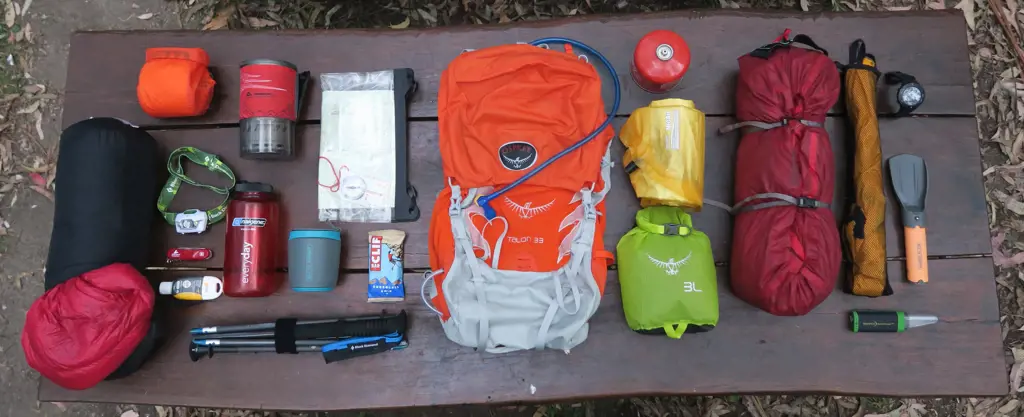
When planning for a day hike, it is important to pack the right items to ensure your safety and comfort on the trail. In addition to the basic essentials such as water, food, and appropriate clothing, there are a few additional items and safety precautions that you should consider before heading out on your hike.
- Map and Compass: Even if you are familiar with the trail, it is always a good idea to carry a map and compass. These tools can be invaluable in case you get lost or need to find an alternate route. Make sure to familiarize yourself with the map and compass before your hike, as they will not be of much use if you don't know how to use them.
- GPS Device or Smartphone: While a map and compass are essential, having a GPS device or smartphone with a hiking app can provide an added layer of navigation and safety. These devices can help you track your progress, mark waypoints, and even provide real-time weather updates. Just make sure to fully charge your devices before your hike and bring a backup power bank if needed.
- First Aid Kit: Accidents can happen on the trail, so it is crucial to carry a small first aid kit with you. Your kit should include items such as bandages, adhesive tape, antiseptic wipes, tweezers, and any necessary medication or personal medical supplies. It is also a good idea to take a first aid course and learn basic wilderness first aid techniques.
- Whistle and Signal Mirror: These small items can be lifesavers in an emergency. A whistle can be used to attract attention if you are lost or injured, while a signal mirror can be used to reflect sunlight and alert rescuers to your location. Make sure to keep these items easily accessible, such as on a lanyard around your neck or in a pocket.
- Extra Clothing and Rain Gear: Weather in the mountains can change rapidly, so it is important to be prepared for all conditions. Pack an extra layer of clothing, such as a lightweight jacket or fleece, in case temperatures drop unexpectedly. Additionally, bring a waterproof jacket and pants to protect yourself from rain or snow. Even if the forecast calls for clear skies, it is always better to be safe than sorry.
- Sun Protection: Sunburns can be a real nuisance on a hike, so don't forget to pack sun protection items such as sunscreen, sunglasses, and a hat. Choose a sunscreen with a high SPF and apply it liberally to all exposed skin. A wide-brimmed hat can provide extra sun protection for your face, neck, and ears.
- Insect Repellent: Depending on the location and time of year, insects can be a major annoyance on the trail. To protect yourself from mosquito bites and other insects, pack a bottle of insect repellent. Look for a repellent that contains DEET or another effective ingredient and follow the instructions for application.
In addition to packing these items, there are a few important safety precautions to keep in mind before embarking on your hike:
- Check the weather forecast: Before heading out, make sure to check the weather forecast for the area you will be hiking in. If there are any severe weather warnings or unfavorable conditions predicted, consider rescheduling your hike for another day.
- Share your plans: Let someone know where you will be hiking and when you expect to return. This can be a friend, family member, or park ranger. If something goes wrong or you're overdue, they can alert authorities and start a search and rescue operation if necessary.
- Stay on established trails: While it may be tempting to explore off the beaten path, it is important to stick to established trails for your own safety. Venturing off-trail can lead to getting lost or damaging fragile ecosystems.
- Pace yourself and know your limits: Hiking can be physically demanding, especially on steep or rugged terrain. Make sure to set a comfortable pace and take breaks as needed. Listen to your body and don't push yourself beyond your limits.
By packing the right items and following these safety precautions, you can ensure a safe and enjoyable day hike. Remember, it's always better to be prepared than to find yourself in a dangerous situation without the necessary tools and knowledge. So, before you hit the trail, take some time to gather the essential items and educate yourself on the area you will be hiking in. Your safety and comfort depend on it.
Essential Items to Pack for Your Next Travel Nurse Assignment
You may want to see also
Frequently asked questions
For a dayhike, it is important to pack essential items such as a backpack to carry your belongings, plenty of water to stay hydrated, snacks for energy, a map and/or compass for navigation, a first aid kit for emergencies, sunscreen and insect repellent for protection, and suitable clothing and footwear for the weather and terrain.
Hiking poles can be beneficial for some hikers, especially if the terrain is challenging or if you have knee or ankle issues. They provide stability and can help reduce strain on your joints. However, they are not necessary for every hiker and it ultimately comes down to personal preference. If you feel more comfortable and confident with a hiking pole, then it is a good idea to bring one.
It is always a good idea to bring extra layers of clothing for a dayhike, even if the weather seems mild. Weather conditions can change quickly, especially in mountainous areas, so having extra layers will ensure you are prepared for unexpected changes in temperature or precipitation. It is recommended to bring a lightweight waterproof or windproof jacket, a hat or beanie, gloves, and possibly an extra pair of socks.
While it is not necessary to bring your cell phone on a dayhike, it is highly advised to have it with you for safety purposes. Your cell phone can be a valuable tool in case of emergencies, such as calling for help if you get lost or injured. Additionally, you can use your phone for GPS navigation, taking photos, or checking the weather forecast. Just make sure to keep it fully charged and carry it in a waterproof bag to protect it from moisture.







